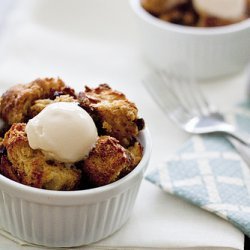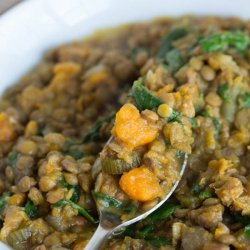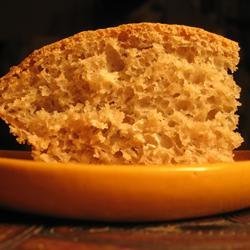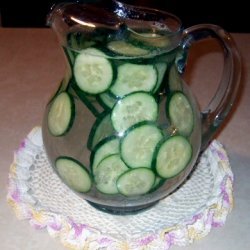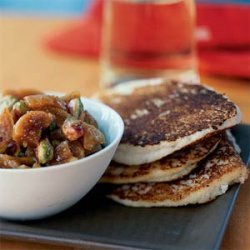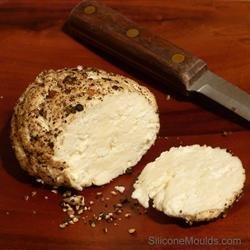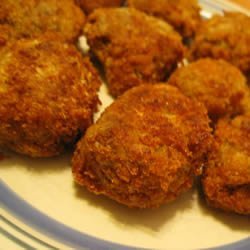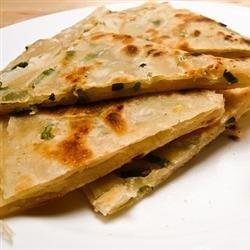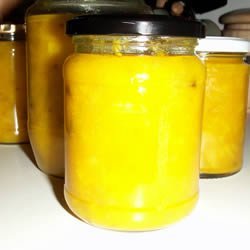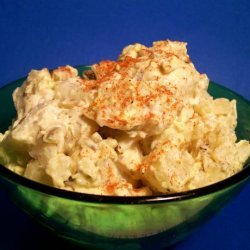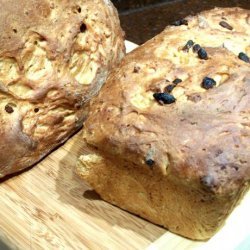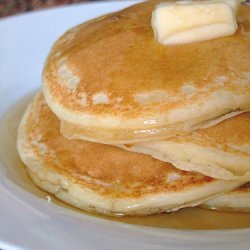Ingredients:
- 4 to 4 3/4 cups (20 to 24 oz) 20 percent bran wheat flour
- 1 1/4 cups (6-oz) 20 percent bran wheat flour
- full batch chef, procedure and recipe follows
Directions:
- Measure the ingredients and calculate the temperatures. Combine the levain and water in a 6-quart bowl. Break up the levain well with a wooden spoon or squeeze through your fingers until it is broken up. Continue stirring until the levain is partially dissolved and the mixture is slightly frothy. Add 1 cup (5 ounces) of the flour and stir until well combined. Add the salt and just enough of the remaining flour to make a thick mass that is difficult to stir. Turn out onto a lightly floured surface and knead, adding remaining flour when needed, until dough is firm and smooth, 15 to 17 minutes total. The dough is ready when a little dough pulled from the mass springs back quickly.
- Shape the dough into a ball and let it rest on a lightly floured surface while you scrape, clean, and lightly oil the large bowl. Place the dough in the bowl and turn once to coat with oil. Take the dough's temperature, the ideal is 78 degrees. Cover with a clean damp towel or plastic wrap and put in a moderately warm (74 to 80 degrees F) draft-free place until increased in volume about 1/4 to 1/2.
- This dough will not behave like an ordinary yeasted bread dough. It won't rise to a puffy state.
- Deflate the dough by pushing down in the center and pulling up on the sides. Transfer to a lightly floured work surface and knead briefly. Shape into a tight ball and place on a lightly floured board. Cover with a clean damp towel or plastic wrap and put in a moderately warm (74 to 80 degree) draft-free place for 30 minutes.
- Flatten the ball with the heel of your hand on a lightly floured work surface into a disk. Shape into an oblong loaf about 14 inches long. Place the loaf seam side up in a well-floured couche*. Cover with a clean damp towel or plastic wrap and put in a moderately warm (74 to 80 degrees F) draft-free place until almost doubled in volume, or until a slight indentation remains when the dough is pressed with a fingertip. This dough gets softer, lighter, and very delicate as it proofs-more so than any other dough in this book. After 4 hours there will be a pronounced difference between the dough you set in the couche and the final light dough.
- Preheat the oven and baking stone to 450 degrees, 45 minutes to 1 hour before baking. The oven rack must be in the center of the oven. If it is in the lower 1/3 of the oven the bottom of the breads may burn, and if it is in the upper 1/3, the top crusts may burn.
- Using the couche as an aid, gently roll the loaf from the couche onto a lightly floured peel so that it sits seam side down. Using a very sharp, serrated knife or a single-edged razor blade, score the loaf by making quick shallow cuts 1/4 to 1/2-inch deep along the surface. Using the peel, slide the loaf onto the hearth. Quickly spray the inner walls and floor of the oven with cold water from a spritzer bottle. If there's an electric light bulb in the oven, avoid spraying it directly?it may burst. Spray for several seconds until steam has filled the oven. Quickly close the door to trap the steam and bake 3 minutes. Spray again in the same way, closing the door immediately so that steam doesn't escape. Bake until the loaf begins to color, about 20 minutes. Reduce heat to 400 degrees and continue baking until deep golden in color and the crust is firm, 20 to 25 minutes.
- To test the loaf for doneness, remove and hold the loaf upside down. Strike the bottom firmly with your finger. If the sound is hollow, the bread is done. If it doesn't sound hollow, bake 5 minutes longer. Cool completely on a wire rack.
- Levain Starter:
- Add the flour directly into the container with the full batch of room-temperature, batterlike ripe chef. Stir vigorously to add fresh oxygen to the mixture. This will form a stiff consistency more like a stiff dough than a batter. This firm texture is important for ripening levain, because a dense rather than loose levain creates delicious sour bread without an overpowering tangy bite. Scrape down the sides, cover tightly, and let stand in a cool to moderate (about 70 degrees) draft-free place for 8 to 10 hours.
- The levain should have doubled in volume. The texture will be somewhat light, with many tiny bubbles throughout. Do not let the levain stand for longer than 10 hours, or the yeast will become exhausted and not raise the final dough. This recipe yields 18 ounces of levain.
- The Chef
- Day 1
- 3/4 cup plus 2 tablespoons (4 ounces) 20 percent bran wheat flour
- 1/2 cup (4 fluid ounces) spring water
- Combine the flour and water in a tall 2 to 3-quart clear plastic container with a lid. Stir well to make a thick, soft dough. The exact consistency of the dough will vary with the brand of flour or water at this point to adjust the texture. Scrape down the sides with a rubber spatula, cover tightly with lid and let stand in a moderate (about 70 degree) place for 24 hours.
- Day 2
- 3/4 cup plus 2 tablespoons (4 ounces) 20 percent bran wheat flour
- 1/2 cup (4 fluid ounces) spring water
- The chef should have almost doubled in volume. You will see tiny bubbles on the surface, and you might notice a slight musty smell. Add the flour and water to the mixture and stir vigorously to distribute the fresh ingredients and add fresh oxygen to the chef. The texture will still be like a soft dough. You may add a little more flour or water to make this texture, if necessary. Scrape down the sides, cover, and place in a moderate (70 degree) draft-free place for 24 hours.
- Day 3 3/4 cup plus 2 tablespoons (4 ounces) 20 percent bran wheat flour 1/2 cup (4 fluid ounces) spring water
- It will have almost doubled in volume and be quite bubbly. Add the flour and water, and stir well to make a thick batter. (You may have to add a little more water if your flour's absorption level is high). With a marker pen, mark the level of the chef on the side of the container. Scrape down the sides, cover tightly, and let stand in a moderate (70 degree) draft-free place for 24 hours.
- It should now be loose in texture, like a pancake batter. It will have doubled in volume from the last addition of flour and water. The chef may rise and fall, but as long as it doubles at some point during this last period, it's fine. You now have a fully ripe chef ready to transform into a levain. If you don't want to make the levain immediately, the chef can be refrigerated for up to 3 days.
- Note: If the dough temperature is higher than 78 degrees, put it in a cooler than (78 degree F) place like the refrigerator, until the dough cools to 78 degrees. If it is lower than 78 degrees, put in it a warmer than 78 degree place until the dough warms to 78 degrees. The point is to try to keep the dough at 78 degrees during its fermentation. If you do have to move the dough, be gentle and don't jostle it, or the dough may deflate.
- *Couche?French for couch or resting place . This is a simple holding device you make yourself for proofing long loaves like logs, torpedo shapes, and baguettes. Using well-floured canvas or linen towels create folds to separate loaves while hold them securely next to each other during proofing. Use a length of fabric at least a yard long. Place 12 to 16-inch wooden blocks cut from 2 by 4's at either long end to contain the loaves. Or substitute large books to contain the loaves.
Nutrition Facts
| Amount Per 1 Serving | |||
| Calories | 1418.78 Kcal (5940 kJ) | ||
| Calories from fat | 192.71 Kcal | ||
| % Daily Value* | |||
| Total Fat | 21.41g | 33% | |
|---|---|---|---|
| Sodium | 13298.51mg | 554% | |
| Potassium | 2.27mg | 0% | |
| Total Carbs | 285.62g | 95% | |
| Sugars | 5.87g | 23% | |
| Dietary Fiber | 42.73g | 171% | |
| Protein | 46.64g | 93% | |
| Iron | 13.6mg | 76% | |
| Calcium | 278.6mg | 28% | |
| Amount Per 100 g | |||
| Calories | 935.56 Kcal (3917 kJ) | ||
| Calories from fat | 127.08 Kcal | ||
| % Daily Value* | |||
| Total Fat | 14.12g | 33% | |
|---|---|---|---|
| Sodium | 8769.21mg | 554% | |
| Potassium | 1.5mg | 0% | |
| Total Carbs | 188.34g | 95% | |
| Sugars | 3.87g | 23% | |
| Dietary Fiber | 28.18g | 171% | |
| Protein | 30.76g | 93% | |
| Iron | 9mg | 76% | |
| Calcium | 183.7mg | 28% | |
* Percent Daily Values are based on a 2000 calorie diet. Your daily values may be higher or lower depending on your calorie needs.
Find out how many calories should you eat.
Get Your Recipe of Health!
Follow RecipeOfHealth on Facebook!


